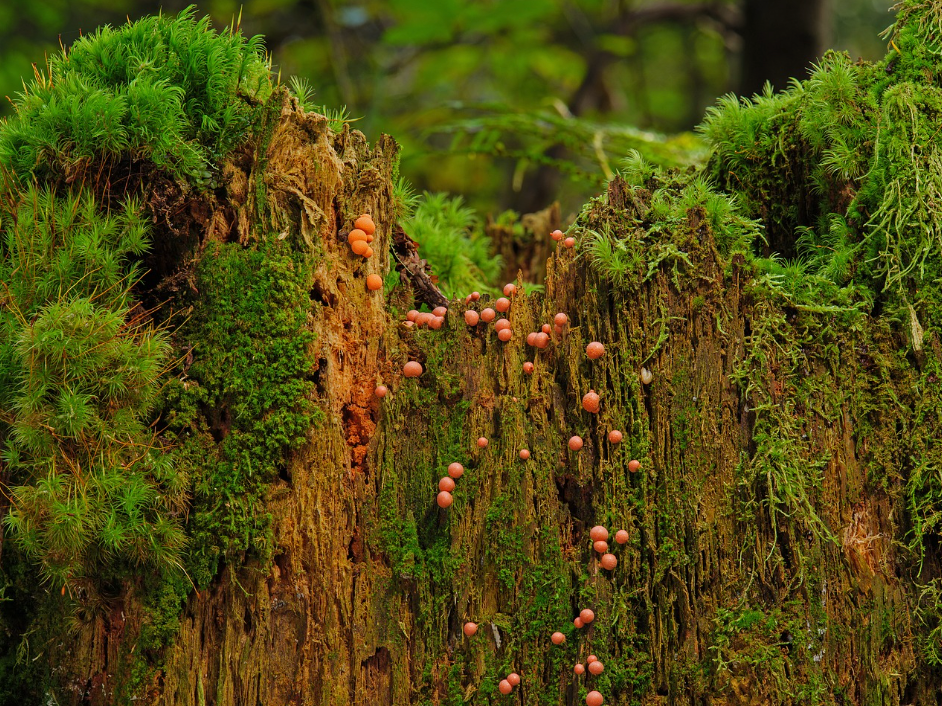by Lauren Lim

Wolf’s milk slime mold (Pixabay)
Slime molds are mysterious and easily misunderstood organisms. For one thing, it’s not mold—it’s not even in the same taxonomic kingdom as mold (Jabr, 2012). Slime molds are typically found in damp forest environments and are often easy to spot with their bright colors and odd formation. Some of the over 900 species of slime molds even have strange names—take wolf’s milk or carnival candy, for example. Slime molds also don’t have brains, so one might think they operate quite simply.
In reality, slime molds are uniquely intelligent.
We typically think of cells as microscopic, but slime molds are one of the exceptions to this, and really they defy most of our expectations of a cell. Slime molds are unicellular organisms that don’t fall under the categories of animal, plant, or fungus, leaving them in the kingdom Protista. The term “slime mold” is also a sort of umbrella term, but the most well known types of slime molds are myxomycetes (The Editors of Encyclopaedia Britannica, 1998). These slime molds have two main phases: plasmodial and fruiting. In the plasmodial phase, slime molds are essentially large blobs of cytoplasm with thousands of nuclei. The reason this is still unicellular is because the entire thing is bound by only one cell membrane, and this giant cell is called a plasmodium. Plasmodiums grow and look for food as they ‘ooze’ around amorphously; they could spread thinly across a surface or collect into one distinct path. When reproducing, the plasmodiums form sporangia, which in turn produce spores. Like fungi, the spores release new cells. Called swarm cells, they have external flagella to help them move around and eventually form plasmodiums again.
The most recognized and studied species of slime mold is probably Physarum polycephalum, a type of myxomycete. Easily recognizable with its bright yellow web of veins, Physarum has been studied for its intelligence. Without any human sensory organs, slime molds can smell food (Greenberg, 2020). Similar to receptors that animals have in their noses, slime molds have receptors for odors along their membranes. When researchers placed slime mold in a maze with oat flakes at the beginning and end, the slime mold could branch out and find its way to the food.
More significantly, the slime mold would eventually shrink back from dead ends until it only connects the two pieces of food, essentially finding the fastest path through the maze. Slime mold’s navigational skills don’t end here. Even without a brain, slime molds can “remember” where they’ve been in order to most efficiently move through or search their environments (Greenberg, 2020). By leaving a trail of slime, Physarum can track where it has been, creating a sort of “externalized spatial memory” (Reid et al., 2012). While this and other strange findings about slime molds invite further exploration, the experiment with Physarum that spotlights slime mold's potential regards the Tokyo subway system.

Yellow myxomycete on forest floor (Pixabay)
When researchers at Hokkaido University placed oat flakes in the arrangement of Tokyo’s subway stations and let a slime mold look for food, it spread out in search as expected. The impressive part is how, after finding its food sources, the slime mold retracted any extraneous webs and thickened the veins that led to pieces of food (Nast, 2010). The resulting network was uncannily similar to the actual Tokyo subway paths. Like humans, slime molds identify the most efficient paths, resulting in very similar results. Similar experiments have been repeated with European and Canadian transportation networks, and each time the slime molds were able to recreate the human-engineered pathways.
Researchers still don’t know much about slime molds, but they’ve already discovered a variety of ways that slime molds are mysteriously smart. Physarum polycephalum introduces how unicellular organisms could have very complex and even intelligent behaviors. This invites research into not only slime molds but also other seemingly simple forms of life that might have something to teach us.
References
Greenberg, A. (2020, September 21). Eight smart things slime molds can do without a brain. NOVA | PBS. https://www.pbs.org/wgbh/nova/article/slime-mold-smart-brainless-cognition/
Jabr, F. (2012). How brainless slime molds redefine intelligence. Nature. https://doi.org/10.1038/nature.2012.11811
Nast, C. (2010, January 22). Slime mold grows network just like Tokyo rail system. WIRED. https://www.wired.com/2010/01/slime-mold-grows-network-just-like-tokyo-rail-system/
Reid, C., Latty, T., Dussutour, A., & Beekman, M. (2012). Slime mold uses an externalized spatial “memory” to navigate in complex environments. Proceedings of the National Academy of Sciences of the United States of America, 109(43), 17490–17494. https://doi.org/10.1073/pnas.1215037109
The Editors of Encyclopaedia Britannica. (1998, July 20). Myxomycetes | Slime molds, Fungus-Like & Protists. Encyclopedia Britannica. https://www.britannica.com/science/Myxomycetes


Comments